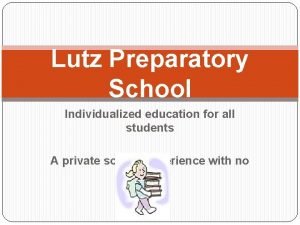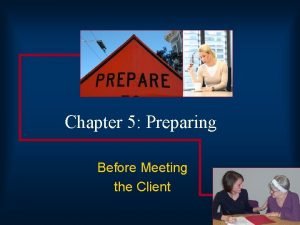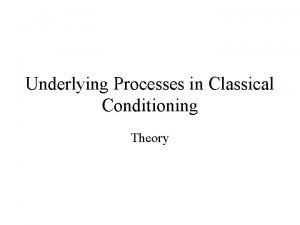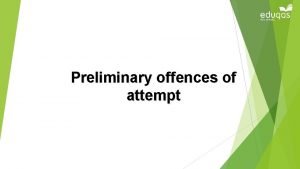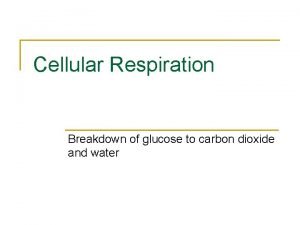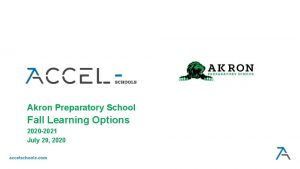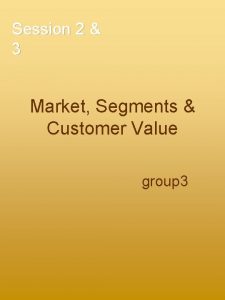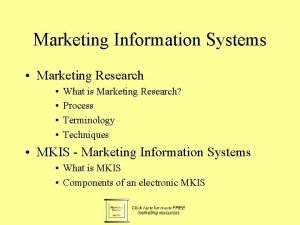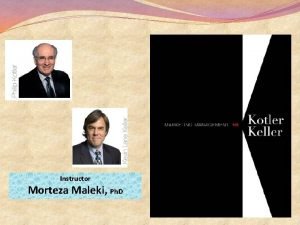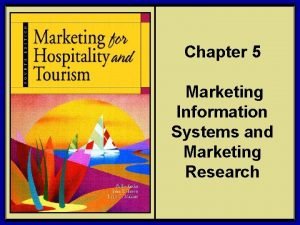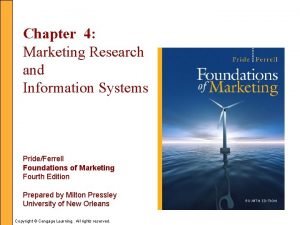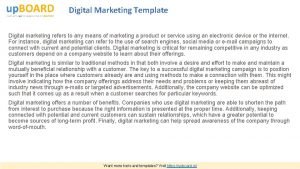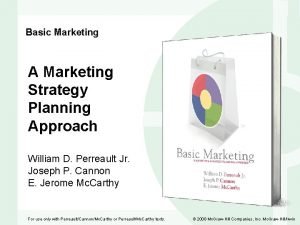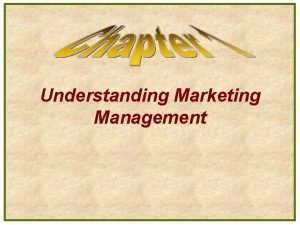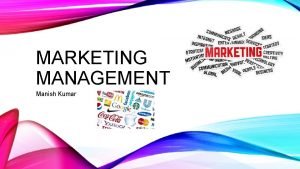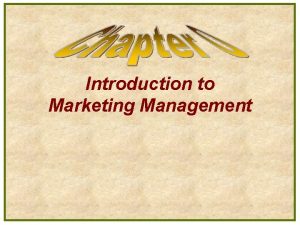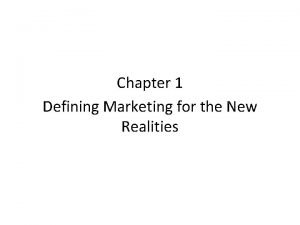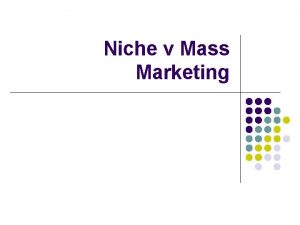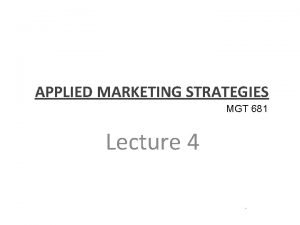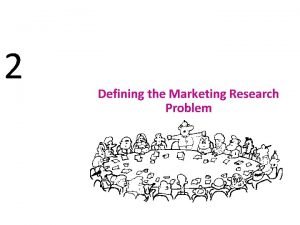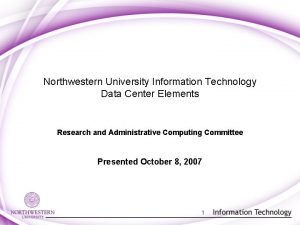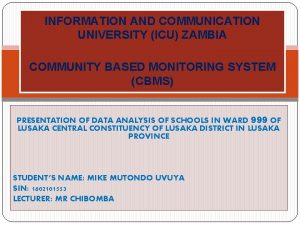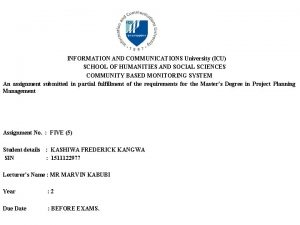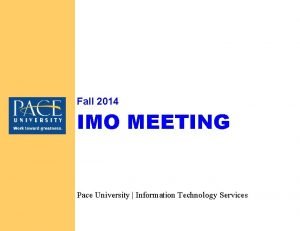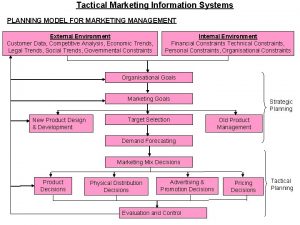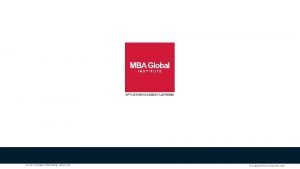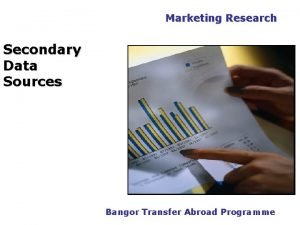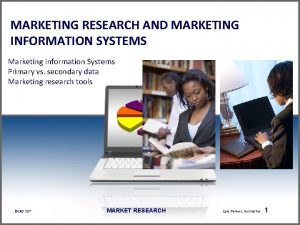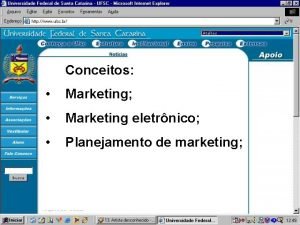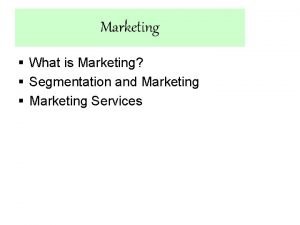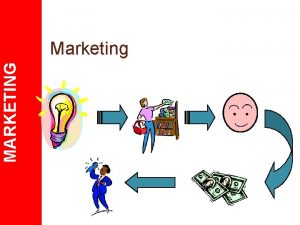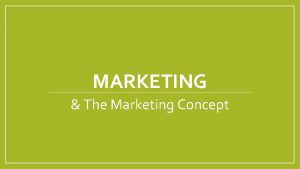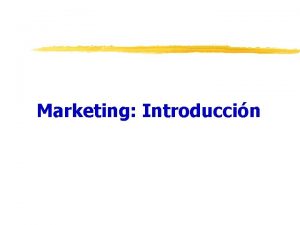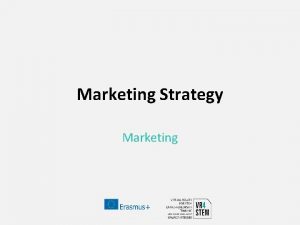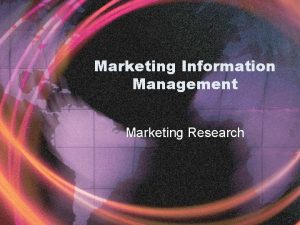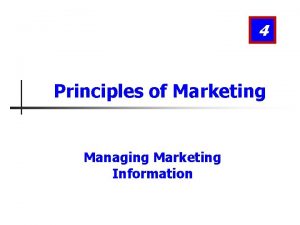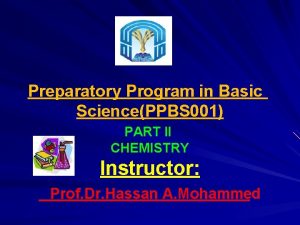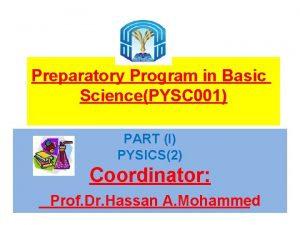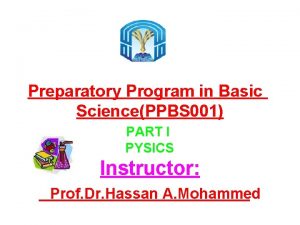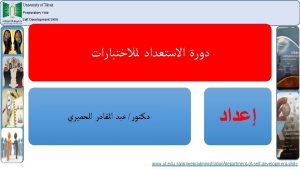Information Marketing preparatory courseNeisse University Part 1 Information

























































- Slides: 57

Information Marketing (preparatory course-Neisse University) Part 1 - Information Ing. Athanasios Podaras, Ph. D Liberec 2017

OUTLINE PART 1: Information • Data, Information, Knowledge: Definitions and Relationships • Information Systems in Modern Organizations • Business Processes and Business Functions in the Modern Business Era • Communication Tools in the Modern Internet Era • Literature PART 2: Marketing • Marketing and Sales as a Functional Area in Enterprises • Marketing on Internet and E-Commerce Strategy • Modern Trends Internet Marketing • Literature

• PART 1: INFORMATION

Data • Data is the plural form of the latin word DATUM ( ‘ a thing or something given’) Data can be defined as a representation of facts, concepts, or instructions in a formalized manner, which should be suitable for communication, interpretation, or processing by human or electronic machine. Data Characteristics: • Data: raw (or unprocessed) information • “Data is not very udeful by itself unless it is converted into KNOWLEDGE” (Pathak, 2014) • Data must be properly processed, transformed in order to be interpreted

Data • Data Sources: in the modern era we mostly refer to “digitized data” • In the context of digitized data the main data sources are: - Databases - Data files - Data Streams

Data Digitization: Definition 1: conversion of information in digital format so that it can be readable by a computer. Definition 2: converting an analog signal (continuous) into a digital signal (non-continuous). Digital information is in form of binary digits (0, 1) known as bits.

Data 1 bit = the basic binary unit of information in computer science 1 byte= 8 bits (1 single ASCII character)

Data ASCII: American Standard Code for Information Exchange. • 1 KB = 210 Bytes (1024 Bytes) • 1 GB = 220 Bytes (108576 Bytes) • 1 TB = 230 Bytes (1, 010. 1012 Bytes)

Data Digital Economy: also known the Internet Economy, is an economy based on online transactions It includes digital wireless communication networks (e. g. , the Internet, intranets, extranets, and VANs), computers, software, and other related information technologies. (Turban et al. , 2015)

Database: A database is a shared collection of logically related data, and a description of that data, designed to meet the information needs and support the activities of an organization. Database Management System (DBMS): A software system used to define, create, manipulate and administer a database

Data Relational Database Management System (RDBMS): A DBMS based on the Relational Model (Codd, 1970). The relational model has a simple data structure, a relation (or table) composed of one or several attributes (or columns) (Vaisman et al, 2014)

The Representation of the Relational Model (Vaisman et al. , 2014)

INFORMATION • The concept of Information “The concept of information is widely, and increasingly, used in a variety of disciplines” (Bawden & Robinson, 2016). Information: 1. data that are processed to be useful; provides answers to "who", "what", "where", and "when" questions (Ackoff, 1989) 2. organized or classified data, which has some meaningful values for the receiver. Information is the processed data on which decisions and actions are based (https: //www. tutorialspoint. com/computer_fundamentals/computer_data. ht m)

Information Basic characteristics: • Timely • Accurate • Complete

Knowledge • Knowledge: the appropriate collection of information, such that it's intent is to be useful (http: //www. systemsthinking. org/dikw. htm)

Example 1: Data Subject Semester Student SUB 1 SPR ST 1 SUB 1 SPR ST 2 SUB 2 WTR ST 1

Example 2: Information Subject Semester Student SUB 1 SPR ST 1 SUB 1 SPR ST 2 SUB 2 WTR ST 1 Semester_ID Semester SPR Spring Semester WTR Winter Semester STUDENT_ID Name Surname Address ST 1 John Smith New York 2 ST 2 Jane Taylor Vienna 3

The Relationship Data-Information. Knowledge http: //www. systems-thinking. org/dikw. htm

Information, Knowledge and Decision Making (via examples) • Information: John Smith attends 2 courses • Knowledge: More students have been enrolled for the Spring Semester courses • Decision Making (based on information and obtained knowledge): Enrichment of the Winter Semester study program

Information Systems and Processes in the Modern Business Era System: A set of components that interact one another in order to complete or achieve a specific goal.

Characteristics of any type of SYSTEM • Systems have specific structure, and are formulated by specific components, also called subsystems. Components are very important to the entire operation of a system. A system can be upgraded by improving the operation of 1 component and not necessarily the entire system. • Systems also have specific behavior, it contains processes that transform inputs (every information that enters the system) into outputs (informationthat leaving the system (material, energy or data). • The components of a system are interrelated. In many cases, the task of a component cannot be implemented until another component finishes another task. System has a boundary, which specifies its limits and separates it from other systems. System’s components all cooperate in order to achieve a specific goal or Purpose • • • System should face constraints in its functioning because not all tasks should be implemented within a system (i. e. tasks, regulations of operations e. t. c. )

Feedback and Control

Feedback and Control • Control is the process that measures current performance and guides it towards a predetermined goal • Positive feedback: reinforces the operation of a system by causing it to continue its performance and activities without changes. • Negative feedback is corrective feedback that helps maintain the system within a critical operating range and reduces performance fluctuations around the norm or standard.

Types of Systems • Open systems that interact freely with its environment, taking input and returning output. It permits interaction across its boundary • • Closed systems that do not interact with the outside environment • • Physical systems are represented by visible entities, are static (i. e. an organization with buildings, workers, rooms, offices e. t. c. ) or dynamic (i. e. a computer program that changes behavior according to the commands of the user), and can be seen or counted. • • Abstract systems are conceptual models that cannot be seen or counted and exist in theoretical level (i. e. social system in sociology, religious system)

Information System • Information System is a collection of interrelated components that collect, process, store, and provide as output the information needed to complete a business task. • • Control and management have an informational nature, that is among all the possible inputs and outputs (information, energy, and material) they use the only one – the information. • This information system should be able to provide management with information for making the decisions necessary in a competitive environment.

Types of Information Systems • Transaction processing systems (TPS) capture and record information about the transactions that affect the organization. A transaction occurs each time a sale is made, supplies are ordered, an interest payment is made. • • Management information systems (MIS) are systems that take information captured by TPS and produce reports that management needs for planning and controlling the business. MIS are possible because the information has been captured by the TPS and placed in organizational databases. • • Executive information systems (EIS) provide information for executives to use in strategic planning. Some of the information comes from the organizational databases, but much of the information comes from external sources – news about competitors, stock market reports, economic forecasts, and so on.

Types of Information Systems • Expert systems (ES) replicate the decision-making process rather than manipulating information. If-then-else rules or other knowledge representation forms describe the way a real expert would approach situations in a specific domain of problems. Typically, users communicate with an ES through an interactive dialogue. The ES asks questions (which an expert would ask) and the end user supplies the answers. Those answers are then used to determine which rules apply, and the ES provides a recommendation based on the rules. • Communication support systems (CSS) allow employees to communicate with each other and with customers and suppliers. Communication support now includes e-mail, fax, Internet access, and video conferencing. • Office support systems (OSS) help employees create and share documents, including reports, proposals, and memos. OSS also help to maintain information about work schedule and meetings. • Geographic Information System (GIS) help employees create and share documents, including reports, proposals, and memos. OSS also help to maintain information about work schedule and meetings.

Important Notice: !!!!! A Computer (-Based) Information System is essentially an IS using computer technology to carry out some or all of its planned tasks. The basic components of computer based information system are: • Hardware- these are the devices like the monitor, processor, printer and keyboard, all of which work together to accept, process, show data and information. • Software- are the programs that allow the hardware to process the data. • Databases- are the gathering of associated files or tables containing related data. • Networks- are a connecting system that allows diverse computers to distribute resources. • Procedures- are the commands for combining the components above to process information and produce the preferred output. Computer System is a device comprised of hardware and software, which is programmed to execute logical and arithmetic operations

Business Processes Business: “An organizational entity that deploys resources to provide customers with desired products or services”. (Laguna and Marklund , 2005) Business Process (Definition 1) The business process is defined by Brady et al. (2001) as: “a collection of activities that takes one or more kinds of input and creates an output that is of value to the customer” Definition 2: Robson and Ullah (1996) defined a business process as: “A flow of work passing from one person to the next, and for larger processes probably from one department to the next”.

• A major process is one that usually involves more than one function within the organizational structure, and its operation has a significant impact on the way the organization functions; • A subprocess is a portion of a major process that accomplishes a specific objective in support of the major process; • Activities are things that go on within a process or subprocess; they are usually performed by units of one (one person or one department) • Tasks are individual elements and/or subsets of an activity; tasks relate to how an item performs a specific assignment. Definitions made by Harrington et al. (1997)

Business Function: On the other hand a “function, is a structured set of activities, services or operations that are delivered by the institution or group to third parties (including its clients, counterparties, etc. )” [European Banking Authority, 2014]. Business Function: captures how work is organized from the managerial viewpoint

Business Process Hierarchy (Harrington et al, 1997)

Business Process Management (BPM) is a management discipline concerned with lifting an organisation’s performance through improvement, management and control of business processes (Jeston and Nelis 2006).

Communication “Communication” • has been thoroughly analysed over the years from various scientific aspects. • is a core element of human behavior • is a crucial factor which influences the development of global civilization Communication is mainly realized by means of information transmission among people. People share information, influence others, establish relationships, form ordered units and act in concert. That is why “communication scientists consider the process of communication one of the important foundations of human society” (Ren and Zhai, 2014)

Communication in the modern era. Internet and Basic Terminologies ICT: Information and Communication Technologies Internet: It is a worldwide/global system of interconnected computer networks. Every computer in Internet is identified by a unique IP address. Browser: software tool for retrieving, presenting and traversing information resources on the world wide web (www) TCP: Transaction Control Protocol IP: Internet Protocol IP Address is a unique set of numbers (such as 110. 55. 35. 104) which identifies a computer’s location.

• DNS (Domain Name Server): a computer used to provide an IP address so that a user is able to locate a computer by a name. i. e. a DNS server will resolve a name https: //www. tul. cz to a particular IP address to uniquely identify the computer on which this website is hosted.

www: worldwide web: a universal collection of various resources (documents, videos, pictures, texts e. t. c. ) – MUST BE DISTINCTED FROM Internet http: Hypetrext Transfer Protocol Hypertext: text displayed in computer in the form of references (Hyperlinks) from which someone (a reader) can have direct access to other text

• HTML: Hypertext Markup Language is the standard programming language for developing web pages and applications • Example of HTML Code: <!DOCTYPE html> <title>HTML Tutorial</title> <body> <h 1>This is a heading</h 1> <p>This is a paragraph. </p> </body> </html>

Literature Ackoff, R. L. , "From Data to Wisdom", Journal of Applied Systems Analysis, Volume 16, 1989 p 3 -9. Bawden, D. , and Robinson, L. (2016). Super-Science, Fundamental Dimension, Way of Being: Library and Information Science in an Age of Messages, Information Cultures in a Digital Age, Springer, ISBN: 978 -3 -658 -146795 Brady, A. J. , Monk, F. E. , & Wagner, J. B. (2001). Concepts in enterprise resource planning. Boston: Course Technology Thomson Learning. Harrington, H. J. , Esseling, E. , & van Nimwegen, H. (1997). Business process improvement. Workbook. New York: Mc. Graw-Hill. Jeston, J. , & Nelis, J. (2006). Business process management. Oxford: Butterworth-Heinemann Laguna, M. , & Marklund, J. (2005). Business process modeling, simulation, and design. Upper Saddle River: Pearson Prentice Hall. Pathak, M. A. (2014). Beginning Data Science with R, Springer DOI: 10. 1007/978 -3 -319 -12066 -9_1. Ren, F. , Zhai, J. (2014). History of Science and Technology Communication & Popularization of Science & Technology in China, China science & Technology Press and Springer-Verlag Berlin Heidelberg 2014, ISBN: 978 -3 -642 -39560 -4 Robson, M. , & Ullah, P. (1996). A practical guide to business process re-engineering. Hampshire: Gower Vaisman, A et al. (2014). Data Warehouse Systems, Data-Centric Systems and Applications, DOI 10. 1007/978 -3 -64254655 -6 2, Springer-Verlag Berlin Heidelberg. http: //www. systems-thinking. org/dikw. htm https: //www. tutorialspoint. com/computer_fundamentals/computer_data. htm)

PART 2: MARKETING

Definition Marketing: A ‘’societal and managerial process by which individuals and organizations obtain what they need and want through creating and exchanging value with others’’ (Kotler and Keller 2012). A marketer is ‘’someone who seeks a response (attention, a purchase, a vote, a donation) from another party, called the prospect’’ (Bickoff et al, 2014)

Marketing as a Functional Area: ‘a certain organizational unit or department within the company or organization, where a set of tightly connected business functions and activities are carried out in order to accomplish a particular kind of work in accordance with the specialization of the functional area’. (Damij and Damij, 2014)

Marketing: This functional area is related to the Marketing branch: carries out marketing analysis that enables the people in the department to develop a good promotional plan for the products and services of the company, which is created on the basis of a realistic analysis of the market Marketing is also involved in calculating and suggesting the best possible prices of the company’s products and services in comparison with the prices of other competitive products. (Damij and Damij, 2014)

Marketing on the Internet and Electronic Commerce

E-Commerce / E- Business/Electronic Market E-Commerce: “Using the Internet and intranets to purchase, sell, transport or trade data, goods or services” E-Business: “e-Business refers to a broader definition of e-Commerce, not just the buying and selling of goods and services, but conducting all kinds of business online such as: - Servicing customers - Collaborating with business partners - Conducting electronic transactions within an organization. ” (Turban et al. , 2015)

Electronic Market • Definition: “E-Commerce can be conducted in an electronic market (or emarketplace) where buyers and sellers conduct commercial transactions such as selling goods, services or information” (Turban et al. , 2015). An e-Marketplace is connected to sellers and byers via the -Internet, -Intranet, -Extranet

Intranet is a counterpart of internet Intranet: a corporate or government internal network that uses internet tools (i. e. web browsers and internet protocols). Notice: Extranet : a network that uses internet technology to link intranets of different corporations/organizations in a secure way.

E-Commerce Framework • People (users, customers, sellers, intermediaries) • Public Policy (regulations, privacy issues, taxation) • Marketing and Advertising (as in any business) • Partnership • Support of Services (orders, payments, transactions, creation of content)

Marketing Strategy for E-Commerce Strategy: ‘a plan chosen to bring about a desired future’ Three central questions for generating strategic choices: - Where do we compete? (geographical segment, customer groups, domain, choice of technologies) - How do we compete? (how to gain competitive advantage, social responsibility(i. e. ecology), ethical issues- vision and mission of the enterprise) - With whom do we develop key relationships? (collaborators, or even competitors (co-opetition) (Schlegelmilch, 2016)

Internet Marketing Strategy Many companies use a multichannel marketing strategy where one channel is e-commerce

marketing channel • • • information promotion negotiation ordering delivery payment trust information brokerage virtual community participation

Types of Internet advertising • • banners Email selling advertising to consumers web storefronts

Economic role of advertising • • to inform comsumers to increase demand to discourage entry by potential competitors to differentiate the firm from existing competitors

internet charactertistic for marketing communication • • 24 hours online multimedia ubiquity global availability interactive one to one marketing intergration

Characteristics of the Digital Economy • Globalization: Global communication and collaboration • Digitization: Music, books, pictures, software, videos, and more are digitized for fast and inexpensive storage and distribution • Speed: A move to real time transactions • Information overload and Intelligent Search: intelligent tools can help users find what they need

Characteristics of the digital economy • Markets: e-marketplaces • Business Models and Processes • Innovation: rapid appearance of digital innovations • Obsolescence: high rate of obsolescence • Fraud • Wars • Organizations: creation of digital enterprises

Literature Bickhoff, N. , Hollensen, S. & Opresnik, M. (2014). The Quintessence of Marketing-What You Really Need to Know to Manage Your Marketing Activities, Springer, ISBN: 978 -3 -642 -45443 -1 Damij, N. and Damij, T. (2014): Process Management, Progress in IS, DOI 10. 1007/978 -3 -642 -36639 -0_2, Springer, Heidelberg. Kotler, P. , & Keller, K. (2012). Marketing management (14 th ed. ). Upper Saddle River, NJ: Pearson. Schlegelmilch, B. (2016). Global Marketing Strategy, Management for Professionals, Springer, DOI: 10. 1007/978 -3 -319 -26279 -6_1. Turban et al. (2015). Electronic Commerce. A Managerial and Social Networks Perspective. Springer, ISBN: 978 -3 -319 -10090 -6.
 Palm beach lakes ixl
Palm beach lakes ixl Young women's preparatory academy uniform
Young women's preparatory academy uniform Lutz prep
Lutz prep Pinecrest cove ixl
Pinecrest cove ixl Prepared by client
Prepared by client S-s conditioning
S-s conditioning R v millard and vernon
R v millard and vernon Pinecrest cove ixl
Pinecrest cove ixl James weldon johnson middle
James weldon johnson middle Central point preparatory academy
Central point preparatory academy College preparatory elective examples
College preparatory elective examples Scottsdale preparatory academy
Scottsdale preparatory academy Preparatory change talk examples
Preparatory change talk examples Dothan preparatory academy
Dothan preparatory academy Application software and system software difference
Application software and system software difference Coenzymes in cellular respiration
Coenzymes in cellular respiration Akron preparatory school
Akron preparatory school Northdene preparatory school
Northdene preparatory school Fairfield college preparatory school
Fairfield college preparatory school North columbus preparatory academy
North columbus preparatory academy Finer segmentation
Finer segmentation Marketing information systems and marketing research
Marketing information systems and marketing research Marketing information system and marketing research
Marketing information system and marketing research Marketing information systems and marketing research
Marketing information systems and marketing research Marketing information systems and marketing research
Marketing information systems and marketing research Marketing information systems and marketing research
Marketing information systems and marketing research Part part whole addition
Part part whole addition Part to part ratio definition
Part to part ratio definition Brainpop ratios
Brainpop ratios Technical description
Technical description Bar layout with label
Bar layout with label The part of a shadow surrounding the darkest part
The part of a shadow surrounding the darkest part Part to part variation
Part to part variation 詹景裕
詹景裕 University of san francisco marketing
University of san francisco marketing The production concept holds that
The production concept holds that Digital marketing marketing refers
Digital marketing marketing refers Universal functions of marketing
Universal functions of marketing Marketing meaning in marketing management
Marketing meaning in marketing management Definition of marketing management
Definition of marketing management Marketing meaning in marketing management
Marketing meaning in marketing management Defining marketing for the new realities
Defining marketing for the new realities Principles of marketing grade 11 module 2 answer key
Principles of marketing grade 11 module 2 answer key Disadvantages of niche marketing
Disadvantages of niche marketing Performance marketing in holistic marketing
Performance marketing in holistic marketing Research problem definition
Research problem definition Northwestern mailroom
Northwestern mailroom Icu zambia
Icu zambia Tashkent university of information technologies
Tashkent university of information technologies Department of information engineering university of padova
Department of information engineering university of padova Information engineering padova
Information engineering padova Information and communications university
Information and communications university Pace university information technology
Pace university information technology Tactical information systems
Tactical information systems Kotler et al 2017
Kotler et al 2017 Marketing information system kotler
Marketing information system kotler Benefits of secondary research
Benefits of secondary research Marketing research process kotler
Marketing research process kotler


